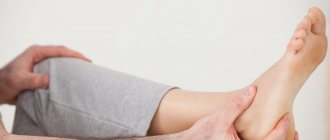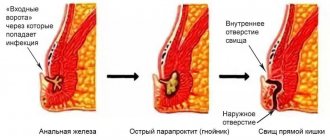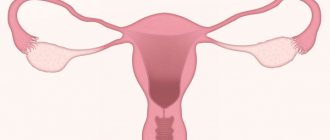Specialist: Gastroenterologist
TO GET A CONSULTATION
Description of the disease Symptoms Causes Diagnostics Treatment Prevention Pinworms are protocavity worms ranging in size from 2 to 12 mm, often living in the intestines of a child and causing significant harm to the child’s body. The diagnosis and treatment of this disease is carried out by a pediatrician, gastroenterologist and infectious disease specialist.
Content
- The causative agent of parasitic infection is pinworm
- Causes of pinworm infection
- What complications does the disease cause?
- Symptoms of the disease Acute period
- Chronic stage
Enterobiasis is an infection of the body with helminths - pinworms. Young children are at risk, but children of other ages can also be infected.
The causative agent of parasitic infection is pinworm
Enterobiasis is caused by the pinworm parasite. This helminth is a roundworm belonging to the class of nematodes. It has some features in appearance. Females grow to a length of 9-12 mm, they have a “tail” - a pointed end. It severely injures the intestinal mucosa when the worm is in the body. Males are 2-3 times smaller than females, and their “tails” are curved in a spiral. Source: https://www.ncbi.nlm.nih.gov/pmc/articles/PMC2306321/ JP Caldwell Pinworms (Enterobius Vermicularis) Can Fam Physician. 1982 Feb; 28: 306–309.
Adult helminths live in the cecum and at the end of the small intestine. At night, females crawl out of the cecum through the anus. At this time, the person’s anal sphincter is relaxed, so nothing interferes with the worms. When the female pinworm emerges, she lays eggs in the perianal folds. There are a lot of eggs - up to 15 thousand. Having laid them, the female dies. The entire cycle of her life is about a month. The eggs are resistant to environmental factors and can remain viable for up to 3 weeks. They stain clothes and bedding.
After a few hours, the embryo from the egg becomes a larva, which itself begins to parasitize. This is how enterobiasis spreads. Pinworms can penetrate the thickness of the intestinal mucosa, causing the formation of granulomas. Sometimes worms crawl into the vagina, uterus and ovaries. Because of this, the female organs become inflamed.
How long do eggs live in the external environment?
Pinworm eggs can live outside the human body for about 30 days. But for their life to continue, certain conditions are needed: humidity should be 70%, and the temperature for convenience should be from 22 to 40 degrees.
Any violation of temperature and humidity can lead to the death of parasites. That is why it is advised to carefully iron bedding and underwear, and it is advisable to iron carpet paths along which infected pets and small children can run.
When identifying the disease, doctors strongly recommend disinfecting all toys or simply taking them out into the cold for a long time, where the offspring of helminths die.
What complications does the disease cause?
When the parasite attaches to the intestinal wall, it secretes a harmful secretion and damages the mucous membrane. In the latter case, poorly healing ulcers form and hemorrhages occur. If tissues are deeply damaged, inflamed granulomas appear. They consist of abnormally overgrown cells, lymph and blood. Due to the fact that pinworms injure the intestines, children experience abdominal pain. The microflora is disrupted and dysbacteriosis occurs.
When the female crawls out, she damages the soft tissue. The perianal area is irritated by the secretion of the worm - abrasions, cracks, eczematous rash, and neurodermatitis appear. If the helminth penetrates the genitals of girls, endometritis and other gynecological diseases may develop.
In the presence of pinworms the acidity of the stomach decreases , food is digested worse, and the course of intestinal diseases becomes more complicated . Parasites reduce immunity, because of them the effectiveness of vaccinations decreases and the number of side effects from them increases. Medicine knows of cases where pinworms pierced the rectum and entered the abdominal cavity, followed by peritonitis.
Being in the organs of the gastrointestinal tract, parasites cause the following complications:
- inflammation of the pelvis and peritoneum;
- acute skin lesions in the perirectal area;
- stagnation of feces in the cecum;
- pyoderma;
- anemia;
- developmental delay of the child;
- disturbance of appetite and sleep; Source: R.A. Fayzullina, E.A. Samorodnova, V.M. Dobrokvashina Helminth infections in childhood // Practical Medicine, 3(42) May 2010.
- in girls – cystitis, vulvitis;
- in boys - enuresis;
- anal fissures.
Symptoms of the disease
There are many signs that a child is infected with pinworms. However, not all of them are characteristic of this disease. Therefore, children are often treated for colitis or gastritis. If there are few parasites in the body, then there may be no symptoms at all. If the disease continues for a long time, anemia occurs , the condition of nails, hair, skin worsens, and the corners of the mouth crack.
Enterobiasis has an incubation period of 1-1.5 months . The “brightness” of the clinical picture depends on the strength of the immune system and the number of worms.
There are two types of disease - acute and chronic. Everyone has their own symptoms.
Acute period
Most often, nausea, abdominal discomfort, weakness in the morning, and frequent stools occur, although they are well formed.
Chronic stage
From the moment of infection to the chronic stage, 1-2 months pass. Symptoms may remain the same as in the acute form or worsen. The main manifestations of chronic enterobiasis:
- flatulence;
- itching in the anus, which becomes stronger at night, it lasts 4-5 days, then disappears and appears again after 2-3 weeks;
- heaviness and pain in the epigastric region;
- insomnia;
- enuresis at night;
- irritability;
- increased fatigue;
- neurological symptoms - problems communicating with peers, deterioration of memory, attention, isolation, headache.
Diagnostic methods
The diagnosis of enterobiasis is based on the examination of scrapings from the surface of the skin of the perianal zone to detect pinworm eggs. The material for research is collected with a spatula from the surface of the skin or an imprint is made on adhesive transparent tape (Graham method). Previously, a smear was taken with a cotton swab attached to a stick, but now the use of a spatula or adhesive tape is considered more effective. In severe cases of the disease, not only eggs, but also large numbers of adult pinworms are found in stool samples taken for analysis. To confirm the diagnosis, samples are taken three times at intervals of one to two days.
The doctor may order a clinical blood test to detect eosinophils, which is necessary in cases where not too much time has passed since the infection.
Treatment methods for detecting pinworms in a child
To treat enterobiasis, the doctor prescribes anthelmintic drugs. The dosage is determined according to the age and weight of the patient. It must be remembered that all these drugs are highly toxic and can cause adverse reactions. Pediatricians do not recommend choosing medications without consulting a specialist.
If a child is diagnosed with pinworms, then all family members need to undergo treatment. If there is a pet living in the house, it is also necessary to purchase anti-worm medication for it.
During treatment, it is also necessary to take sorbents, since anthelmintic drugs do not remove parasites from the body.
An effective regimen for taking medications and necessary procedures is prescribed by the doctor.
A number of hygiene procedures for the home are necessary:
- after the end of treatment, change the linen by ironing it with a hot iron;
- boil or wash the toys in hot water with added salt;
- Regularly carry out wet cleaning at home.
Diagnosis of enterobiasis in children
Some believe that infection occurs from pets
If they detect signs of pinworms in their children, parents contact their pediatrician. He, in turn, can prescribe an examination himself, or send him for a consultation with a gastroenterologist and parasitologist. First of all, the specialist will conduct a survey, including basic questions to determine a possible diagnosis. Key questions will include:
- Main complaints
- First symptoms and when they appeared
- How many family members have similar symptoms?
- Does the family practice good hygiene?
The next step will be to assign research:
- Examination of feces. The laboratory takes a stool test for worm eggs. For the analysis to be reliable, it is necessary to take the biomass to the laboratory within an hour after defecation. It is necessary to prevent urine from coming into contact with feces. Analysis from different parts of the stool is collected in a disinfected container. 2 teaspoons are enough for an accurate diagnosis. If the basic rules are not followed, the result may be unreliable.
- Scraping in the anal area. The study is carried out in the morning. The patient should not go to the toilet before this and should not wash himself. The procedure is quite simple: a special film is applied to the skin area. Helminth eggs stick to it, which can be detected under a microscope.
- Blood tests. A general blood test is done. In the presence of enterobiasis, eosinophilia is detected - an increase in eosinophils in the blood. In rare cases, anemia is detected, a decrease in hemoglobin and red blood cells. This disease can be caused by a large number of helminths and a simultaneous infectious disease
If there are any signs of enterobiasis, it is recommended to immediately visit a doctor and undergo the necessary tests. Timely detection and treatment of the disease eliminates the development of complications.
Disease prevention
To prevent a child from becoming infected with parasites, he needs to instill personal hygiene skills and ensure that:
- his nails were trimmed;
- he had no contact with street animals;
- did not put dirty objects into his mouth. Source: Clinical recommendations (treatment protocol) for providing medical care to children with enterobiasis, Federal State Budgetary Institution Scientific Research Institute of Infectious Diseases, Federal Medical and Biological Agency of Russia, Public organization "Eurasian Society for Infectious Diseases", Public organization "Association of Infectious Disease Doctors of St. Petersburg and the Leningrad Region" (AVISPO)
If you suspect enterobiasis in a child, you should consult a doctor as soon as possible and undergo a course of treatment. You can make an appointment with a medical pediatrician 24 hours a day by phone or leave a request to have a doctor come to your home.
Sources:
- https://www.ncbi.nlm.nih.gov/pmc/articles/PMC2306321/JP Caldwell Pinworms (Enterobius Vermicularis) Can Fam Physician. 1982 Feb; 28: 306–309.
- R.A. Fayzullina, E.A. Samorodnova, V.M. Dobrokvashina Helminth infections in childhood // Practical Medicine, 3(42) May 2010.
- Clinical recommendations (treatment protocol) for the provision of medical care to children with enterobiasis FGBU NIIDI FMBA RUSSIA, Public organization "Eurasian Society for Infectious Diseases", Public organization "Association of Infectious Disease Doctors of St. Petersburg and the Leningrad Region" (AVISPO)
Markova Daria Olegovna Clinic
Author of the article
Markova Daria Olegovna
Specialty: pediatrician
Experience: 14 years
The information in this article is provided for reference purposes and does not replace advice from a qualified professional. Don't self-medicate! At the first signs of illness, you should consult a doctor.
Causes of infection
Most often, doctors detect enterobiasis in children, since they are much more likely than adults to:
- do not follow hygiene rules: do not wash their hands after contact with potentially contaminated surfaces, soil, visiting a public bathroom, before eating, etc.;
- eat on the street;
- lick or suck fingers, toys and other objects;
- They bite their fingernails.
The same actions cause helminthic infection in adults: enterobiasis is often called the disease of dirty hands.
Prices
| Name of service (price list incomplete) | Price |
| Online opinion of a pediatrician (SPECIAL) | 0 rub. |
| Appointment (examination, consultation) with a pediatrician, primary, therapeutic and diagnostic, outpatient | 1750 rub. |
| Consultation (interpretation) with analyzes from third parties | 2250 rub. |
| Prescription of treatment regimen (for up to 1 month) | 1800 rub. |
| Consultation with a candidate of medical sciences | 2500 rub. |








